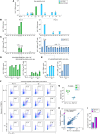Proviral location affects cognate peptide-induced virus production and immune recognition of HIV-1-infected T cell clones
- PMID: 37698927
- PMCID: PMC10617777
- DOI: 10.1172/JCI171097
Proviral location affects cognate peptide-induced virus production and immune recognition of HIV-1-infected T cell clones
Abstract
BACKGROUNDHIV-1-infected CD4+ T cells contribute to latent reservoir persistence by proliferating while avoiding immune recognition. Integration features of intact proviruses in elite controllers (ECs) and people on long-term therapy suggest that proviruses in specific chromosomal locations can evade immune surveillance. However, direct evidence of this mechanism is missing.METHODSIn this case report, we characterized integration sites and full genome sequences of expanded T cell clones in an EC before and after chemoradiation. We identified the cognate peptide of infected clones to investigate cell proliferation and virus production induced by T cell activation, and susceptibility to autologous CD8+ T cells.RESULTSThe proviral landscape was dominated by 2 large clones with replication-competent proviruses integrated into zinc finger (ZNF) genes (ZNF470 and ZNF721) in locations previously associated with deeper latency. A third nearly intact provirus, with a stop codon in Pol, was integrated into an intergenic site. Upon stimulation with cognate Gag peptides, infected clones proliferated extensively and produced virus, but the provirus in ZNF721 was 200-fold less inducible. While autologous CD8+ T cells decreased the proliferation of cells carrying the intergenic provirus, they had no effect on cells with the provirus in the ZNF721 gene.CONCLUSIONSWe provide direct evidence that upon activation of infected clones by cognate antigen, the lower inducibility of intact proviruses in ZNF genes can result in immune evasion and persistence.FUNDINGOffice of the NIH Director and National Institute of Dental & Craniofacial Research; NIAID, NIH; Johns Hopkins University Center for AIDS Research.
Keywords: AIDS/HIV; Cellular immune response.
Figures





References
Publication types
MeSH terms
Grants and funding
LinkOut - more resources
Full Text Sources
Medical
Molecular Biology Databases
Research Materials

